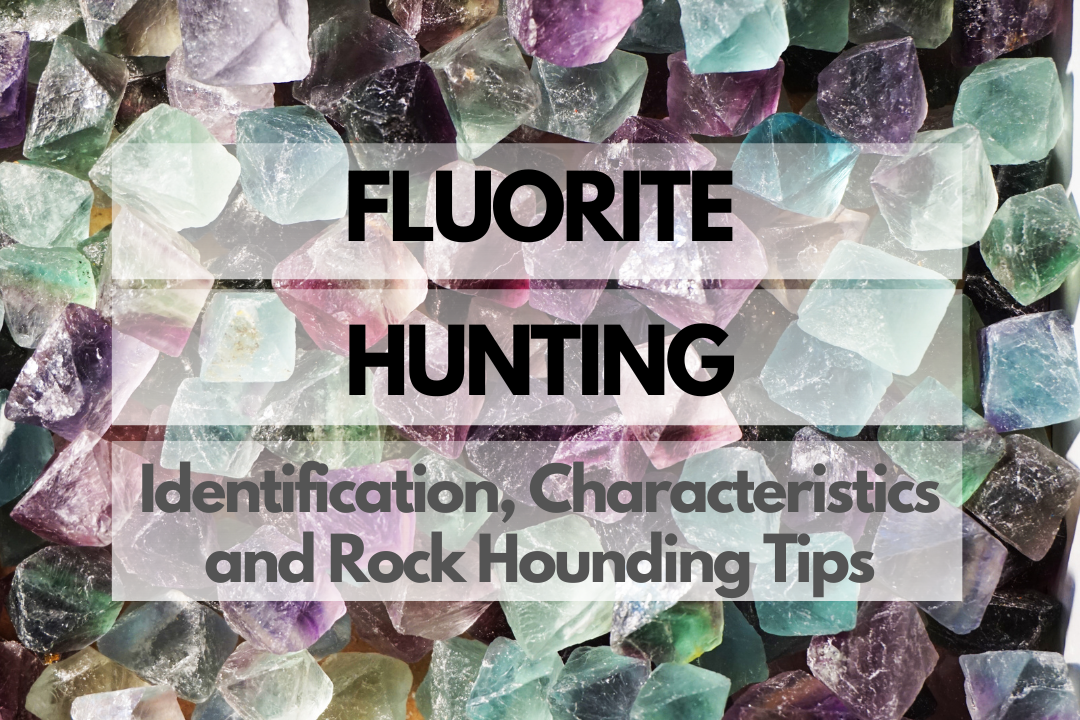Discover the fascinating world of fluorite hunting and immerse yourself in the beauty of these stunning minerals. Renowned for their vibrant colors and cubic crystal structures, fluorite specimens are a favorite among rock hounds and mineral enthusiasts. In this article, we’ll delve into the history and origin of fluorite, explore its identification and physical properties, and share valuable tips for finding and collecting these captivating gems.
History & Origin of Fluorite
Fluorite, also known as fluorspar, is a mineral composed of calcium fluoride (CaF2). It was first described in 1530 by Georgius Agricola, a German mineralogist, and has been highly valued for its stunning colors and unique crystal formations ever since. The name “fluorite” is derived from the Latin word “fluere,” meaning “to flow,” as the mineral was initially used as a flux in smelting operations to help metals flow more easily during the process.
Fluorite has held cultural significance in various civilizations throughout history. In Ancient Egypt, for example, it was carved into statues and amulets, while in China, it has been used for centuries to create intricate carvings and decorative pieces.
Fluorite Identification & Physical Properties
To help you identify and distinguish fluorite from other minerals, we’ve compiled an overview of its key physical properties in the table below:
| Property | Description |
|---|---|
| Chemical Formula | CaF2 |
| Crystal System | Cubic |
| Cleavage | Perfect in four directions, forming octahedrons |
| Luster | Vitreous (glassy) |
| Transparency | Transparent to translucent |
| Streak | White |
| Specific Gravity | 3.18 |
Fluorite Colors
One of the most striking features of fluorite is its wide range of colors, which include purple, green, blue, yellow, and more. Some specimens even display multiple colors or color zoning, with bands of different hues throughout the crystal. The colors in fluorite are caused by various impurities and defects within the crystal lattice, as well as exposure to natural radiation over time.
Fluorite Hardness
Fluorite has a relatively low hardness of 4 on the Mohs scale, which means that it can be scratched by a knife or steel nail. Due to its softness, fluorite is not ideal for use in jewelry or other applications where it may be exposed to rough handling or abrasion. However, its remarkable colors and crystal formations make it a highly prized mineral for collectors.
Fluorite Types
Cubic Fluorite
Cubic fluorite is characterized by its well-formed cubic crystal habit, which is the most common shape for this mineral. The edges and corners of these crystals may be sharp and well-defined, or they may exhibit more rounded or stepped features.
Octahedral Fluorite
Octahedral fluorite is less common than cubic fluorite and exhibits an eight-sided (octahedral) crystal habit. These crystals often form as a result of the natural cleavage of cubic fluorite along its internal planes, creating a unique, geometric appearance.
Botryoidal Fluorite
Botryoidal fluorite is characterized by rounded, grape-like clusters of small fluorite crystals. These formations are relatively rare and are typically found lining the walls of mineral cavities or coating other minerals.
Fluorite Uses
Fluorite has a wide range of uses, including:
- Industrial applications: As a flux in the production of steel and aluminum, and in the manufacture of hydrofluoric acid, which is used in various industries including glass etchingand electronics.
- Optical applications: Due to its low dispersion and high transparency, fluorite is used in the manufacturing of lenses for cameras, telescopes, and microscopes.
- Decorative pieces: Fluorite’s vibrant colors and unique crystal formations make it a popular choice for creating ornamental items, such as carved figurines, bookends, and decorative bowls.
- Collectible specimens: The stunning colors and crystalline beauty of fluorite make it a favorite among mineral collectors and rock hounds.
- Metaphysical purposes: Fluorite is often used in crystal healing and energy work due to its purported ability to enhance mental clarity, focus, and balance.
How Much Is Fluorite Worth?
The value of fluorite specimens can vary greatly depending on factors such as size, color, clarity, and crystal formation. Small, common specimens can be purchased for just a few dollars, while larger, high-quality specimens with exceptional colors and crystal formations can sell for hundreds or even thousands of dollars. Ultimately, the worth of a fluorite specimen is determined by its rarity, beauty, and the demand among collectors and enthusiasts.
Fluorite Rock Hounding Tips
Embarking on a fluorite hunting adventure can be an exciting and rewarding experience. To make the most of your rock hounding journey, follow these tips and tricks for a successful hunt:
Essential Tools and Equipment
Equipping yourself with the right tools and gear can make all the difference in your fluorite hunting endeavors. Some essential items to consider bringing along include:
- Rock hammer or geologist’s pick for breaking rocks and extracting specimens
- Chisels and pry bars to help separate and remove fluorite crystals from their surrounding rock
- Safety goggles to protect your eyes from flying rock fragments
- Hand lens or magnifying glass to closely examine and identify samples
- Field notebook and pen for recording your findings and observations
- Sturdy gloves to protect your hands
- Containers or bags for safely storing and transporting your specimens
Safety Tips
Staying safe while rock hounding is crucial, so be sure to keep the following safety tips in mind:
- Always wear appropriate safety gear, including goggles, gloves, and sturdy footwear
- Be mindful of your surroundings and watch for potential hazards, such as loose rocks, steep inclines, or slippery surfaces
- Stay hydrated and carry plenty of water with you, particularly in hot or arid locations
- Inform someone of your plans and estimated return time, in case of emergency
- Respect posted signs, private property, and local regulations
Fluorite Hunting: Where to Find Fluorite
Fluorite can be found in various locations around the world, with some of the best-known deposits located in the United States, England, Mexico, and China. To help you plan your fluorite hunting adventure, we’ve compiled a table detailing some specific sites and areas where you can find this beautiful mineral:
| Site/Area | City/State/Country |
|---|---|
| Illinois Fluorspar District | Hardin County, Illinois, USA |
| Rogerley Mine | Weardale, County Durham, England |
| Naica Mine | Chihuahua, Mexico |
| Xianghualing Mine | Hunan Province, China |
Caring For Your Fluorite
Proper care is essential to preserving the beauty and integrity of your fluorite specimens. Keep the following tips in mind when handling and displaying your collection:
- Store and display your fluorite specimens away from direct sunlight, as prolonged exposure can cause the colors to fade
- Avoid placing fluorite in high-traffic areas where it may be bumped or knocked over, as its relatively low hardness makes it more susceptible to damage
- When cleaning your fluorite, use a soft cloth and avoid abrasive cleaners or chemicals that could scratch or damage the surface
Additional Resources
Expand your knowledge and connect with fellow fluorite enthusiasts by exploring the following resources:
- Government geological surveys, such as the United States Geological Survey (USGS) or the British Geological Survey (BGS)
- Scientific articles and publications, such as the American Mineralogist or the Mineralogical Society
- Online forums and communities, such as Mindat.org or Rock & Mineral Shows
- Books, such as “Collector’s Guide to Fluorite” by Jessie La Plante or “Fluorite: TheCollector’s Choice” by Peter Megaw
Additional Fluorite FAQs
What are the benefits of Fluorite?
Fluorite is a popular mineral among collectors due to its vibrant colors and unique crystal structures. It is also used industrially as a flux in the production of steel, aluminum, and other metals, as well as in the manufacture of certain types of glass and ceramics. Additionally, fluorite is used as a source of fluorine for the production of hydrofluoric acid, which has numerous applications in various industries.
Do Fluorite have any healing properties?
While some people believe that fluorite has healing properties and may use it for crystal therapy, there is no scientific evidence to support these claims. It is important to consult with a medical professional for any health concerns or issues you may have.
Do Fluorite have any spiritual meaning?
In some spiritual and metaphysical circles, fluorite is believed to possess various properties, such as enhancing mental clarity, improving decision-making, and protecting against negative energy. However, these beliefs are not supported by scientific evidence and should be viewed as personal opinions or traditions rather than established facts.
Do I need a permit to go Fluorite hunting?
In some cases, you may need a permit to go fluorite hunting, particularly if you plan to collect specimens on public lands or in designated collecting areas. It is crucial to research and adhere to local regulations and acquire any necessary permits before embarking on your rock hounding adventure. For more information on permits in the United States, visit the Bureau of Land Management (BLM) website.
Closing Thoughts
Exploring the world of fluorite rock hounding can be an incredibly rewarding and fulfilling experience. Equipped with the right tools, knowledge, and safety precautions, you’ll be well on your way to uncovering stunning specimens and creating lasting memories. So, gather your gear, do your research, and set out on your very own fluorite hunting adventure!

